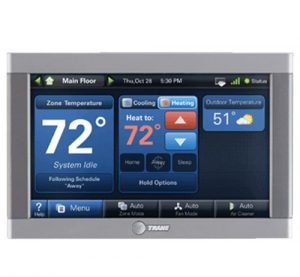When it comes to heating your home or business, selecting the right furnace size is crucial. The furnace is the heart of your heating system, and its size directly impacts your comfort, energy efficiency, and operating costs.
If you choose a furnace that is too small, it may not provide adequate heat during cold weather, leaving you and your family or employees shivering. On the other hand, an oversized furnace wastes energy, cycles on and off too frequently, and may not provide even heating throughout your space.
This article will help you determine the appropriate furnace size for your home or business.
Need further assistance? Contact us at (855) 345-6161 or leave us a message, today!
Why Furnace Size Matters: The Consequences of Undersized and Oversized Furnaces
Most homeowners pay very little attention to their home’s furnace size. Unfortunately, this can lead to inefficient heating, higher utility bills, and other problems.
Let’s take a closer look at the consequences of getting an undersized or oversized AC unit for your home.
Undersized Furnaces: Struggling to Keep Up
An undersized furnace will struggle to keep your space warm during colder months. This can lead to:
- Insufficient heating: Rooms may be cold and uncomfortable, especially during extreme weather conditions.
- Increased energy consumption: The furnace will work harder to maintain the desired temperature, consuming more energy and leading to higher utility bills.
- Shorter lifespan: Constantly running at maximum capacity can cause premature wear and tear, reducing the furnace’s overall lifespan.
Oversized Furnaces: Wasting Energy and Reducing Comfort
An oversized furnace may seem like a better option, but it comes with its own set of problems:
- Short-cycling: The furnace will frequently turn on and off, which can cause uneven heating and reduced efficiency.
- Increased wear and tear: The constant cycling puts additional strain on the furnace’s components, potentially leading to more frequent repairs and a shorter lifespan.
- Higher initial costs: Larger furnaces are generally more expensive to purchase and install.
General Gas Furnace Size Guidelines for Homes
The table below provides general guidelines for gas furnace size based on the square footage of your home.
Note: These guidelines are only a starting point. It’s essential to perform a heating load calculation to determine the most accurate furnace size for your specific situation.
| Home Square Footage | Estimated Furnace Size (BTU/hour) |
| Up to 1,200 | 45,000 – 60,000 |
| 1,200 – 1,800 | 60,000 – 90,000 |
| 1,800 – 2,400 | 90,000 – 120,000 |
| 2,400 – 3,000 | 120,000 – 150,000 |
| 3,000 – 3,600 | 150,000 – 180,000 |
| Over 3,600 | 180,000+ |
Things to Consider When Choosing the Right Furnace Size for Your Home
Selecting the right size furnace for your home is crucial for maintaining comfort, energy efficiency, and cost-effectiveness. While the process may seem overwhelming, taking the following factors into consideration can help you make an informed decision:
1. Climate and Regional Factors
Your home’s location and climate play a significant role in determining the appropriate furnace size.
Colder climates typically require larger furnaces to maintain comfortable temperatures during the winter months.
Additionally, regional factors such as humidity levels and altitude can affect the performance of your furnace and should be considered during the sizing process.
2. Insulation and Air Sealing
The insulation levels and air sealing of your home can significantly impact the size of the furnace needed.
A well-insulated and properly air-sealed home will require a smaller furnace, as less heat is lost through the building envelope.
Before selecting a furnace, consider having an energy audit conducted to identify areas where your home’s insulation and air sealing can be improved.
3. Home Size and Layout
The overall size and layout of your home play a role in determining the right furnace size.
Larger homes and those with multiple levels or open floor plans may require larger furnaces to maintain consistent temperatures throughout the space.
Additionally, homes with high ceilings or large windows may require more heating capacity to compensate for heat loss.
4. Existing Ductwork and Airflow
The existing ductwork and airflow in your home can also impact the furnace size needed.
Properly sized and maintained ductwork is essential for efficient and even heating throughout your home.
If your ductwork is undersized, it may restrict airflow and require a larger furnace to compensate.
A professional HVAC contractor can evaluate your ductwork and make recommendations for improvements if needed.
Contact BelRed Energy Solutions today for reliable furnace installation, repair, and maintenance!
5. Furnace Efficiency Ratings
When selecting a furnace, consider its efficiency rating.
Furnaces with higher efficiency ratings will consume less fuel and produce fewer greenhouse gas emissions.
Annual Fuel Utilization Efficiency (AFUE) is the standard rating system for furnaces, with ratings typically ranging from 80% to 98%.
While higher-efficiency furnaces may have a higher upfront cost, they can save you money on your energy bills in the long run.
6. Future Home Improvements
If you plan on making any significant home improvements, you must consider how these changes may affect your heating needs.
You may need to adjust the furnace size to accommodate these changes.
7. Home Age
The age of your home can influence the appropriate furnace size, as older homes may have less efficient insulation, windows, and construction materials.
Older homes may require a larger furnace to compensate for heat loss.
In contrast, newer homes built with more energy-efficient materials and techniques may need a smaller furnace.
8. Roof Color
The color of your roof can impact the amount of heat absorbed by your home.
Darker roofs tend to absorb more heat, which may lead to a warmer home in the summer and potentially reduce the heating requirements in the winter.
Conversely, lighter-colored roofs can help keep your home cooler during the summer months, but may not have as significant an impact on heating requirements.
9. Sun Exposure
The amount of sun exposure your home receives can play a role in determining the appropriate furnace size.
Homes with ample sun exposure can benefit from passive solar heating, which can help reduce heating requirements.
Consider the orientation of your home, the size and location of windows, and any shading from trees or neighboring structures when selecting a furnace size.
A home with significant sun exposure may require a smaller furnace to account for the additional heat gained from the sun.
Tools for Calculating Heating Load and Selecting a Furnace
Below are some tools you can use to find the right size furnace for your home:
- Manual J: The Air Conditioning Contractors of America (ACCA) developed the Manual J load calculation method, which is widely accepted as the industry standard for determining the heating and cooling loads of residential buildings.
- Software: There are many software programs available that can perform heating load calculations based on the Manual J method. Some popular options include Wrightsoft, Elite Software, and EnergyGauge.
- HVAC Contractors: Hiring a professional HVAC contractor who is experienced in performing load calculations can help ensure that your furnace is sized correctly. Look for contractors with certifications from organizations like ACCA or the North American Technician Excellence (NATE).
- Energy Audits: An energy audit can provide valuable information about your home’s energy efficiency and help you identify areas where improvements can be made. Some energy auditors may also perform heating load calculations as part of their services.
How BelRed Energy Solutions Can Help
BelRed Energy Solutions is committed to helping homeowners choose the best furnace type, size, and efficiency for their homes. Their team of experienced professionals offers the following services to ensure a seamless experience:
- Accurate Load Calculations: BelRed Energy Solutions can perform accurate heating load calculations using industry-standard methods, ensuring your furnace is sized correctly for your home.
- Expert Recommendations: Their knowledgeable staff can guide you through the various furnace types, sizing considerations, and efficiency ratings to help you make an informed decision.
- Installation and Maintenance: BelRed Energy Solutions offers professional installation and maintenance services, ensuring your furnace operates at peak performance for its entire lifespan.
- Energy Audits: By conducting a comprehensive energy audit, BelRed Energy Solutions can identify areas where your home’s energy efficiency can be improved, potentially saving you money on your energy bills.
Contact Us Today!
At BelRed Energy Solutions, our experienced technicians are well-versed in performing accurate heating load calculations and other industry-standard methods. We’ll guide you through the process, taking into account your home’s size, layout, insulation, climate, and other factors that impact furnace sizing.
With our professional guidance, you can be confident that you’re choosing the right size furnace for your home!
In addition to our expert furnace sizing assistance, we offer comprehensive furnace installation, repair, and maintenance services. Our team is dedicated to keeping your heating system running at peak performance throughout its lifespan. If your furnace ever requires repair or maintenance, you can trust our skilled technicians to get the job done right.
Don’t leave your home’s comfort and efficiency to chance – call BelRed Energy Solutions today at (855) 345-6161 to schedule a consultation, today!







